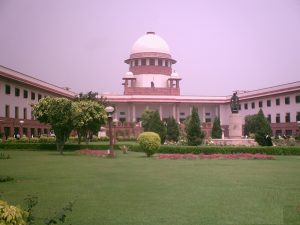On November 7, a five-person bench of India’s Supreme Court ruled 3-2 that the government can reserve 10 percent of the spots in educational institutions and government jobs for members of the Economically Weaker Section (EWS) of society. This includes those who earn less than about $10,000 a year and are not members of the Scheduled Tribes (Adivasis or tribals), Scheduled Castes (Dalits or so-called “Untouchables”), or the Other Backward Class category, which is mostly, but not exclusively, composed of lower castes. In simpler terms, unlike previous reservation schemes in India, this new reservation is based on economic rather than identitarian criteria, although it is effectively a reservation for the poor members of the upper castes from the Brahmin, Kshatriya, and Vaishya groups.
In 2019, the Indian parliament passed the 103rd amendment to the Indian constitution, which modified Articles 15 and 16 to allow for reservations for members of the EWS category. Article 15 forbids discrimination on the basis of “religion, race, caste, sex, [or] place of birth.” However, further clauses in Article 15 allow the state to make special provisions for women, children, Scheduled Castes, Scheduled Tribes, and other socially disadvantaged groups.
When India’s constitution went into effect in 1950, reservations only included members of the most deprived groups, the Scheduled Castes and Tribes. However, in 1990, the Mandal Commission, which was set up by the government in 1980, recommended that another group, the Other Backward Castes (OBCs) be given reservations in government jobs and educational institutions. Though this was implemented, this proved extremely controversial at the time, and led to violent protests, especially among the upper castes. A 1992 Supreme Court ruling, Indra Sawhney & Others v. Union of India, sought to put a stop to runaway reservations by decreeing that reservations should not exceed 50 percent of spots and that economic backwardness alone was not a criterion for reservations.
Reservations were conceived as a way to level the playing field between the hierarchically disparate jatis (castes) that make up Indian society. India has historically been a society of caste groups ranked according to ritual status, with access to resources and influence generally accruing to the highest-ranked castes.
Since the 1990s, however, many of those from the upper castes initially opposed to reservations have instead begun to demand reservations for themselves, so that they too may partake in the division of the pie of government employment. India has a relatively weak private sector and a large informal economy, so government work– sarkari naukri – is seen as a guaranteed source of income, stability, and status. Those who get government jobs are set for life, or so the thinking goes. The problem, according to many activists, was that poor members of the upper castes were suffering from a lack of access to government jobs.
It was for these reasons that the 103rd amendment and the 10 percent EWS quota was brought in, with significant support from multiple parties, although many activists argued that it would privilege upper castes unfairly. In addition to guaranteeing a 10 percent reservation for members of the EWS group, the amendment was necessary in order to overturn the Indra Sawhney decision of 1992 because it sought to extend reservations to those who were merely economically deprived, and by doing so, would push the number of spots reserved beyond the 50 percent cap. After a challenge, the Supreme Court of India upheld the 103rd amendment earlier this month, arguing that it did not violate the basic structure of the constitution.
While it cannot be denied that in a society as stratified as India’s, some reservations for the most deprived castes could be beneficial, India has come a long way from aspiring to be a meritocratic society with some concessions given for the purpose of correction of prior caste abuses to becoming a society where now almost all social groups – except religious minorities – can avail themselves of reservations. That it has done so is evidence that economic growth and social change have not proceeded fast enough to make India a truly casteless society. Unfortunately, the very presence of a quota system based on caste can perpetuate caste, because it incentivizes identifying with caste groups in order to reap the benefits of some reservation or the other, with merit and individualism taking a back seat.
Despite the ruling, most of the justices who sat on the recent Supreme Court bench agreed that reservations should be of a limited duration. Justice Jamshed Burjor Pardiwala, who voted with the majority, wrote in the 117-page verdict that “reservation is not an end but a means – a means to secure social and economic justice. Reservation should not be allowed to become a vested interest. Real solution, however, lies in eliminating the causes that have led to the social, educational, and economic backwardness of the weaker sections of the community.”
It remains to be seen if Indian society will avoid becoming one of vested interests, given the stake so many groups have in the reservation system.

































